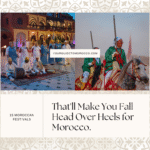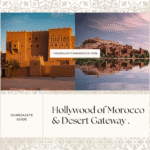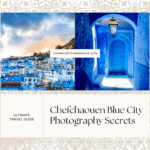Ultimate Fes Travel Guide: 12 Insider Secrets to Navigate Morocco’s Cultural Capital Like a Pro

Ultimate Fes Travel Guide: 12 Insider Secrets to Navigate Morocco’s Cultural Capital Like a Pro
Table of Contents
Picture this: you’re standing at the edge of the world’s largest car-free urban zone, where donkeys still deliver goods through medieval alleyways, and the call to prayer echoes off thousand-year-old walls. Welcome to Fes Morocco travel at its most authentic – a sensory overload that’ll make your Instagram followers weep with envy.
This Fes travel guide isn’t your typical tourist handbook. We’re diving deep into the cultural capital’s secrets, armed with insider knowledge that’ll transform you from wide-eyed wanderer to savvy explorer. Ready to navigate Morocco’s most mesmerizing maze?
1. Why Fes Should Top Your Morocco Bucket List
Let’s be honest – Morocco’s got some serious competition in the “must-visit” department. Marrakech flashes its Instagram-perfect riads, Casablanca serves up that old-world cinema magic, and Chefchaouen paints the town literally blue. So why does Fes Morocco travel deserve the crown?
Simple. Fes is where Morocco keeps its soul.
While other cities have adapted (sometimes grudgingly) to the tourism boom, Fes el-Bali – the UNESCO medina at the city’s heart – remains gloriously, stubbornly authentic. This isn’t a theme park version of medieval Morocco; it’s the real deal, where leather tanners still use techniques from the 11th century and spice merchants hawk their wares from shops that predate Columbus.

The numbers don’t lie: this Fes medina guide covers over 9,000 narrow streets and alleys packed into just 280 hectares. You’ll find the world’s oldest continuously operating university (Al-Qarawiyyin, founded in 859 AD), and artisan workshops where craftsmen create masterpieces using methods passed down through generations.
Ready to experience this magic firsthand? Our 5-Day Imperial Cities Tour includes two full days in Fes with expert local guides who unlock the medina’s best-kept secrets.
But here’s what the guidebooks won’t tell you – Fes rewards the curious traveler. Unlike the aggressive touts of Marrakech’s Jemaa el-Fnaa, Fes locals are genuinely proud of their city’s intellectual heritage. Strike up a conversation with a carpet weaver or metalworker, and you’ll discover stories that’ll stick with you long after you’ve left.
2. Safety First: Is Fes Safe for First-Time Visitors?
Let’s address the elephant in the room – or should I say, the tourist nervously clutching their daypack in the medina?
Safety in Fes for solo travelers is actually better than most people expect. The crime rate for tourists is relatively low, and violent incidents are extremely rare. However, like any medieval city that wasn’t designed for modern tourism, Fes has its quirks that catch newcomers off guard.
The Real Safety Concerns in Fes
Pickpocketing: It happens, but it’s opportunistic rather than aggressive. Keep your valuables in a money belt or secure crossbody bag.
Getting Lost: This is your biggest “danger.” The medina’s layout makes zero sense to modern minds – streets dead-end without warning, and that “shortcut” your riad host mentioned might lead you on a two-hour detour. For comprehensive safety tips across all of Morocco, check out our detailed Morocco Safety Guide for Solo Travelers.
Overly Enthusiastic “Guides”: Self-appointed helpers who’ll “show you the way” for a fee. According to Morocco’s tourism board, only licensed guides should be used for official tours.
Pro Safety Tips That Actually Work
- Download MAPS.ME before you arrive. The offline maps work even in the medina’s narrow alleys where cell service gets patchy.
- Screenshot your riad’s location and the nearest recognizable landmark (usually a gate like Bab Bou Jeloud).
- Trust your instincts. If a situation feels off, politely extract yourself.
- Women travelers: you’ll attract attention, but it’s mostly curiosity rather than harassment. Dress modestly and walk with confidence.
3. Perfect Timing: How Many Days You Need in Fes
Here’s where most travelers mess up their Fes Morocco travel experience – they either rush through in a day trip from Chefchaouen or camp out for a week and run out of steam by day four.
The sweet spot? Three to four days gives you the perfect balance of deep exploration without medina fatigue.
The Ideal Fes Itinerary Breakdown
| Day | Focus | Key Activities |
| Day 1 | Medina Orientation | Fes walking tours, basic navigation, Bou Inania Madrasa |
| Day 2 | Cultural Deep Dive | Chouara Tannery, Al-Qarawiyyin, traditional crafts |
| Day 3 | Ville Nouvelle & Relaxation | French colonial architecture, hammam, rooftop terraces |
| Day 4 | Day Trip Adventure | Meknes, Volubilis, or Chefchaouen excursion |
Two days minimum if you’re on a tight schedule – but honestly, you’ll leave feeling like you’ve only scratched the surface.
Five days or more works if you’re using Fes as a base for multiple day trips or if you’re the type who likes to really absorb a place’s rhythm. The city reveals different layers depending on how long you stay.
Want to maximize your time? Our Fes Desert Adventure combines 3 days exploring the cultural capital with an unforgettable Sahara experience – the perfect introduction to Morocco’s diverse landscapes.

4. Must-See Fes Medina Attractions That Will Blow Your Mind
Every Fes attractions list starts with the obvious suspects, but let’s go beyond the basic tourist checklist. Here are the experiences that’ll actually make you understand why UNESCO deemed this place worthy of protection.
The Heavy Hitters (That Live Up to the Hype)
Al-Qarawiyyin Mosque and University Non-Muslims can’t enter the prayer areas, but peek through the doors – the intricate geometric patterns and ancient columns are mesmerizing. This place was educating scholars when Oxford was still a twinkle in someone’s eye.
Bou Inania Madrasa The only religious building in Fes that non-Muslims can fully explore. The tile work (zellij) and carved cedar ceiling took 20 years to complete – and it shows in every jaw-dropping detail.
Nejjarine Museum of Wooden Arts and Crafts Housed in a beautifully restored funduq (medieval inn), this museum showcases Morocco’s incredible woodworking tradition. The rooftop café offers killer medina views.

The Hidden Gems (Where You’ll Lose the Crowds)
Dar Batha Museum Fes’s answer to the Victoria and Albert Museum. Traditional Moroccan arts in a gorgeous 19th-century palace setting.
Merenid Tombs The tombs themselves are ruins, but the sunset views over the medina are absolutely killer. Pack a picnic and watch the city come alive as the day cools.
Fondouk el-Nejjarine A perfectly preserved medieval caravanserai that now houses a museum. It’s like stepping into a merchant’s time capsule.
Artisan Quarters (Where the Magic Happens)
The Fes medina map and walking route should always include these working neighborhoods:
- Potters’ Quarter: Watch ceramics being fired in traditional kilns
- Blacksmiths’ Area: The rhythmic hammering creates the medina’s industrial soundtrack
- Textile District: Hand-woven fabrics on looms that haven’t changed in centuries
5. Solo vs. Guided Tours: Cracking the Medina Code
This might be the most hotly debated topic in any Fes travel guide: should you brave the medina solo or surrender to a guide?
The honest answer? It depends on what kind of traveler you are.
Fes Walking Tours: The Case for Going Guided
First-timer benefits: A good guide doesn’t just prevent you from getting lost – they unlock stories and context you’d never discover alone. They’ll explain why certain doors are painted specific colors, point out architectural details you’d miss, and get you into workshops that would otherwise ignore tourists.
Time efficiency: You’ll see more in three hours with a knowledgeable guide than in a full day of wandering.
Cultural bridge: Local guides can facilitate interactions with artisans and shopkeepers, turning transactions into cultural exchanges.

The Solo Explorer Advantage
Budget friendly: No guide fees, and you’re less likely to be steered toward commission-heavy shops.
Flexibility: Discover at your own pace, linger where something catches your eye, escape when you’re overwhelmed.
Authentic encounters: Sometimes the best experiences happen when you’re genuinely lost and have to rely on local kindness.
The Hybrid Approach (Recommended)
Take a guided tour on your first day to get oriented, then explore solo for the rest of your stay. Many riads can arrange half-day tours for around 200-300 dirhams ($20-30 USD).
Quality guide indicators:
- Licensed badge from the Moroccan Ministry of Tourism
- Fixed rates (no “pay what you think it’s worth” schemes)
- Recommendations from your riad or reputable booking platforms
6. Airport to Medina: Your Seamless Transfer Game Plan
The Fes airport to medina transfer shouldn’t be your first cultural shock, but often it is. Fès–Saïs Airport sits about 15km from the medina, and your transfer choice sets the tone for your entire visit.
Transfer Options Ranked by Sanity Level
Taxi (Grand or Petit)
- Cost: 150-200 dirhams ($15-20 USD) to the medina
- Pros: Direct, relatively quick (20-30 minutes)
- Cons: Meter negotiation required, potential tourist pricing
Pre-arranged riad transfer
- Cost: 250-350 dirhams ($25-35 USD)
- Pros: Your riad host meets you with a sign, handles luggage, knows exactly where you’re going
- Cons: Slightly more expensive, but worth every dirham for peace of mind

Bus (Line 16)
- Cost: 4 dirhams (about $0.40 USD)
- Pros: Incredibly cheap, local experience
- Cons: Irregular schedule, crowded, not practical with luggage
Pro Transfer Tips
- Cash is king: Have small bills ready – drivers rarely have change for large denominations
- Address specificity: “Medina” isn’t specific enough. Get your riad’s exact location and nearest landmark
- Night arrivals: Stick with pre-arranged transfers if you’re landing after 8 PM
7. Dress Code Decoded: What to Wear in Fes
What to wear in Fes isn’t just about respecting local customs (though that’s important) – it’s about being comfortable while navigating a medieval city in modern times.
The Cultural Context
Fes is more conservative than coastal cities like Casablanca or Rabat. The medina especially maintains traditional values, and dressing appropriately shows respect while helping you blend in better.
Fes cultural etiquette guide: Dressing for Success
For Everyone:
- Cover shoulders and knees when entering religious areas
- Avoid transparent or tight-fitting clothes
- Pack layers – medina temps vary between sun and shade
Women’s specific considerations:
- Long pants or skirts that cover the ankles
- Lightweight scarves are useful for mosque visits and sun protection
- Avoid low necklines or sleeveless tops in the medina
Men’s guidelines:
- Long pants preferred (shorts are okay in tourist areas but avoid them in traditional neighborhoods)
- Collared shirts show respect when visiting religious sites
Practical Wardrobe Essentials
ItemWhy You Need ItSeasonComfortable walking shoesUneven cobblestones and long distancesYear-roundLightweight scarfSun protection and mosque visitsYear-roundLayersTemperature changes throughout the dayAll seasonsHat with brimIntense medina sun reflectionSummerLight jacketEvening cooling and air-conditioned spacesAll seasons
Best time to visit Fes weather considerations:
Spring and Fall: Perfect weather for exploring, but pack layers for temperature swings Summer: Lightweight, breathable fabrics essential – cotton and linen are your friends Winter: Surprisingly chilly – bring warm layers for early mornings and evenings
8. Chouara Tannery: The Smell, The Glory, The Strategy
No Fes medina guide is complete without addressing the elephant in the room – or rather, the overwhelming scent that hits you three blocks before you reach the famous Chouara tannery. This isn’t just a tourist attraction; it’s a living, breathing workshop where leather has been processed using medieval techniques for over a thousand years.
Visiting Chouara tannery tips: What to Expect
The reality check: this place smells. Intensely. We’re talking about centuries-old leather processing using pigeon droppings, cow urine, and various animal fats. The mint sprigs that shop owners offer aren’t just tourist theater – they’re survival tools.
The Process That’ll Amaze You:
- Hides soak in stone vessels filled with natural dyes and tanning solutions
- Workers stomp the leather by hand, just like their ancestors did
- The circular stone vats create a geometric pattern that’s become Instagram-famous

Insert image of Chouara tannery aerial view with colorful vats here Alt text: Visiting Chouara tannery tips colorful vats Fes Morocco traditional leather
Smart Tannery Strategy
Best viewing times:
- Early morning (8-10 AM): Workers are most active, lighting is perfect for photos
- Late afternoon (4-6 PM): Golden hour lighting, fewer crowds
What to bring:
- A bandana or scarf you can discreetly cover your nose with
- Camera with good zoom – you’ll want distance between you and the vats
- Small bills for tips to workers (20-50 dirhams is appropriate)
Photography etiquette: Always ask permission before photographing workers. A small tip usually ensures enthusiastic cooperation.
The Shopping Component
Every tannery visit includes a “brief” stop at the leather shop. Here’s how to handle it like a pro:
- Quality check: Good leather should feel supple, not stiff or plasticky
- Price negotiation: Start at 30% of the asking price
- Shipping reality: International shipping is expensive and often unreliable – only buy what you can carry
9. Riad Life: Choosing Your Perfect Medina Hideaway
Riads in Fes aren’t just accommodation – they’re your sanctuary from medina madness. These traditional courtyard houses offer an authentic Moroccan experience, but choosing the right one can make or break your Fes Morocco travel adventure.
Best riads in Fes medina: What Separates Great from Mediocre
Location indicators of a good riad:
- Within walking distance of major medina gates (especially Bab Bou Jeloud or Bab Ftouh)
- Accessible by car or small van (important for luggage)
- Not too deep in the medina maze (you’ll appreciate this at 2 AM)
Amenities that actually matter:
- Reliable Wi-Fi (surprisingly rare in thick medina walls)
- Hot water consistency (ask specifically about this)
- Rooftop terrace with medina views
- Concierge service for tour bookings and transport

Riad Selection Reality Check
Riad TypePrice RangeBest ForPotential DrawbacksBudget riads$30-60/nightSolo travelers, backpackersBasic amenities, potential noiseMid-range riads$80-150/nightCouples, comfort seekersGood balance of authentic and modernLuxury riads$200+/nightSpecial occasions, luxury travelersCan feel isolated from authentic medina life
Booking Strategies That Work
Direct booking perks: Many riads offer better rates and upgrades when you book directly. Email them for quotes, especially for longer stays.
Platform protection: Use Booking.com for first-night security, then negotiate directly for extended stays.
Seasonal pricing: Best time to visit Fes for riad deals is January-March and November (excluding holidays).
Red Flags to Avoid
- Reviews mentioning “impossible to find” without specific directions
- No recent photos of actual rooms (courtyard shots can be misleading)
- Promises of “airport pickup included” with suspiciously low rates
10. Epic Day Trips: Beyond Fes Boundaries
One of the biggest advantages of Fes Morocco travel is the city’s position as a perfect launch pad for exploring northern Morocco. These day trips from Fes will add serious depth to your Moroccan adventure.
Fes to Chefchaouen day trip: The Blue Pearl Pilgrimage
Distance: 200km (4 hours total driving) Best for: Instagram enthusiasts and mountain lovers Reality check: It’s a long day, but worth every mile
The journey through the Rif Mountains is half the experience. You’ll wind through landscapes that shift from olive groves to pine forests, with glimpses of traditional Berber villages tucked into hillsides.
Click here to see more details about trip to Chefchaouen
Chefchaouen highlights:
- Plaza Uta el-Hammam (the main square perfect for people-watching)
- Ras el-Maa Waterfall (a short hike with mountain views)
- The blue-painted medina (smaller and more manageable than Fes)

Meknes and Volubilis: Imperial History Double Feature
Distance: 60km to Meknes, plus 30km to Volubilis Best for: History buffs and culture enthusiasts Time needed: Full day (8-10 hours)
Meknes was Morocco’s capital under Sultan Moulay Ismail, and the architecture reflects those imperial ambitions. The city feels less touristy than Fes, with wider streets and a more relaxed vibe.
Must-sees in Meknes:
- Bab Mansour gate (arguably Morocco’s most beautiful)
- Moulay Ismail Mausoleum (one of the few religious sites open to non-Muslims)
- Place el-Hedim (the main square, less chaotic than Marrakech’s Jemaa el-Fnaa)
Volubilis is Morocco’s best-preserved Roman site. The mosaics are incredible, and the setting – rolling hills dotted with olive trees – feels almost Mediterranean.
Day Trip Logistics
Transportation options:
- Private driver: 800-1200 dirhams ($80-120 USD) for the day
- Organized tours: 400-600 dirhams per person including guide
- Rental car: Possible but challenging – Moroccan driving requires nerves of steel
Pro timing tip: Start early (8 AM departure) to maximize exploration time and avoid afternoon crowds.
11. Train and Bus Mastery: Connecting Morocco’s Gems
ONCF Morocco travel (the national railway) has transformed intercity travel in Morocco, but navigating the system still requires insider knowledge.
Train from Fes to Marrakech: The Scenic Route
Journey time: 7-8 hours Frequency: 4-5 trains daily Cost: 200-400 dirhams ($20-40 USD) depending on class
This journey showcases Morocco’s geographical diversity – from Fes’s rolling hills through the flat agricultural plains around Casablanca, then into the Atlas foothills approaching Marrakech.
Booking strategies:
- Reserve seats online at oncf-sncf.ma for popular routes
- First class is worth the upgrade for long journeys (AC, wider seats, less crowding)
- Bring snacks – the café car selection is limited
Fes to Casablanca: The Business Express
Journey time: 4 hours Best option: Al Atlas or TNR trains (faster, more comfortable) Pro tip: Book the 7 AM departure to arrive in Casablanca with a full afternoon for exploration
Bus Network Reality
CTM and Supratours offer reliable service to destinations not served by rail:
- Fes to Chefchaouen: 4 hours, 65 dirhams
- Fes to Erfoud (Sahara gateway): 7 hours, 120 dirhams
Bus travel tips:
- Book in advance during Ramadan and school holidays
- Bring layers – AC can be arctic or nonexistent
- Keep valuables with you, not in luggage compartments
12. Stay Connected: SIM Cards vs. Roaming Reality Check
Local SIM card in Morocco versus international roaming isn’t just about saving money – it’s about maintaining your sanity when you’re lost in the medina and need Google Maps to guide you home.
The Connectivity Landscape
Morocco’s three main networks:
- Orange: Best coverage in rural areas
- Inwi: Competitive urban pricing
- Maroc Telecom: Reliable but often pricier
eSIM vs Physical SIM: The Modern Dilemma
eSIM advantages (Airalo, Holafly):
- Instant activation upon landing
- No physical SIM card to lose
- Keep your home number active simultaneously
eSIM limitations:
- Not all phones support eSIM technology
- More expensive per GB than local options
- Customer service can be challenging from Morocco
Cost Comparison Reality Check
OptionInitial CostData AllowanceBest ForRoamingVariesUsually expensive per MBEmergency use onlyeSIM (Airalo)$15-303-10GBConvenience seekersLocal SIM$10-1510-20GBBudget conscious travelers
Practical Purchase Strategy
Airport kiosks: Convenient but often overpriced City center shops: Better deals but require language skills and time Your riad: Many can arrange SIM cards for guests (small markup for convenience)
Pro tip: Download MAPS.ME and offline translation apps before you travel – they work without data connection.
13. Souk Shopping Survival: Avoid Tourist Traps Like a Boss
The souks of Fes aren’t just shopping areas – they’re economic ecosystems that have functioned for over a millennium. But they’re also where many tourists get fleeced, frustrated, or both. Here’s how to shop like a local while respecting the culture and craft traditions.
Understanding the Souk Psychology
The artisan’s perspective: These aren’t factories churning out tourist trinkets. Many workshops have been family-owned for generations, and the craftsmanship represents centuries of knowledge.
The merchant’s reality: Tourism is seasonal and unpredictable. Shopkeepers often make their monthly rent from a few good sales, so initial prices reflect this uncertainty.
Your role: You’re not just a customer – you’re a cultural ambassador. How you behave affects how the next tourist will be treated.

Shopping in Fes souks: The Negotiation Game
Starting prices vs. realistic final prices:
- Carpets: Start at 30% of asking price
- Leather goods: 40-50% is reasonable
- Ceramics and metalwork: 50-60% of initial quote
- Spices: Usually fixed prices, minimal negotiation
Quality Recognition Skills
Carpet authenticity markers:
- Hand-knotted rugs have slight irregularities (machine-made are perfectly uniform)
- Natural dyes fade slightly but evenly
- Check the back – hand-knotted rugs show the same pattern on both sides
Leather quality tests:
- Good leather feels supple and smells earthy, not chemical
- Stitching should be straight and secure
- Traditional Moroccan leather has a distinctive texture
Metalwork evaluation:
- Brass versus brass-plated items (weight is the giveaway)
- Hand-hammered pieces show slight irregularities
- Silver items should be stamped with purity marks
Shopping Etiquette That Opens Doors
Relationship building:
- Accept mint tea when offered (it’s genuine hospitality, not a sales tactic)
- Ask about the craftsperson’s family and training
- Show genuine interest in the creation process
Respectful photography:
- Always ask permission before photographing people or their work
- Offer a small tip (20-50 dirhams) for posed photos
- Don’t photograph without buying something if you’ve spent significant time in a shop
Avoiding Common Tourist Traps
Red flags:
- Pressure to buy immediately (“special price today only”)
- Guides who insist on taking you to “their family’s shop”
- Prices that seem too good to be true (usually fake goods)
Green flags:
- Artisans working in the back of the shop
- Multiple generations of the same family involved
- Willingness to explain the creation process
- Other locals shopping in the same establishment
Your Fes Adventure Starts Now
This Fes travel guide has equipped you with everything you need to navigate Morocco’s cultural capital like a seasoned traveler. From dodging tourist traps in the souks to choosing the perfect riad, you’re ready to experience Fes authentically.
But here’s the thing about Fes – no guide can truly prepare you for the sensory overload of your first morning in the medina. The call to prayer echoing off ancient walls, the aroma of tagines mixing with leather and spices, the sight of craftsmen creating masterpieces in workshops unchanged for centuries.
Ready to plan your Fes adventure?
- Book your riad through direct contact for the best rates
- Download offline maps and translation apps before you travel
- Pack comfortable walking shoes and layers for temperature changes
- Bring cash in small denominations for tips and small purchases
- Most importantly, bring an open mind and sense of adventure
What’s your biggest concern about visiting Fes? Drop a comment below and let’s solve it together. And don’t forget to share this guide with fellow Morocco dreamers who need the inside scoop on navigating this incredible cultural capital.
Your medina adventure awaits – time to get gloriously, beautifully lost in Morocco’s most authentic city.
📍 Ready to Explore Fes? Let’s Make It Happen!
Turn your Morocco dreams into reality with our expert local guidance and authentic cultural experiences.
Get in Touch:
📧 Email: contact@yourguidetomorocco.com
📱 WhatsApp: +212 718448804
🌐 Website: www.yourguidetomorocco.com
📞 Phone: +212 718448804
Connect With Us:
Instagram: @yourguidetomorocco | Facebook: Your guide to morocco | TikTok: @yourguidetomorocco
Quick Response Promise:
- WhatsApp: Instant replies during business hours
- Email: Response within 24 hours
- Custom quotes: Tailored to your travel dates and preferences
🎯 Ready to book your Fes adventure? Message us now for personalized recommendations and exclusive local insights!




